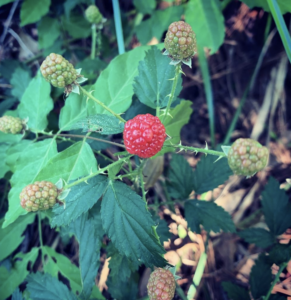We’ve been collecting berries for a few weeks now and have been learning a lot as the plants move through their fruit production cycle. The dewberries started to ripen in early April and tend to move from green to a ripe, dark purple after about only two weeks. The blackberries have been green since the beginning of April as well, but have been taking much longer to grow and ripen. At first, we thought they might be the same berry plant, but we quickly began to realize the two plants fruit differently and grow in slightly different locations. With more than ten species of the Rubus genus native in Texas, it’s hard to say which exact specie of dewberry we are foraging.
About Dewberries
While they can be found growing in the same area, dewberries grow in creeping vines along the ground that can climb a few feet up bushes and tall grass (including blackberry canes). Dewberry vines prefer to grow in areas that are frequently wet, on the wood’s edge, and in bushes that get shade from the trees, but also gets plenty of sunlight. Spanning the area, dewberries can grow into the fields along a wood’s edge as well as into the woods a bit, but they tend to thin out as you get further away from where heavy wooded tree areas meet open fields or wide cut pathways. The vines of dewberry plants remain thin and green throughout the growing season and do not grow as canes. While the dewberry plant does have plenty of thorns, it’s usually fairly easy to pass through areas where dewberries grow.
About Blackberries
Blackberries grow in similar area as dewberries but seem to prefer dryer spots. Blackberries are true to their name bramble and grow thick canes with a perennial root system and biennial canes. The first year the cane grows, it remains green and does not produce fruit. The second year, the cane turns brown and woody and will produce fruit. Unlike dewberry plants, blackberry canes will sprout up in the field of a wood’s edge or sometimes in thin patches of trees and can create an impenetrable wall of vines and thorn.
Now that we know the difference between dewberries and blackberries, we have identified blackberries all over, so it seems we’ll have an extra long berry season. It was raining a lot in early April but has not been so raining as much for the past week, so the berries aren’t growing as large it seems.
Recipe
• 6.5 pounds dewberries
• 4 cups sugar
• 1 large navel orange, zested and juiced
We use this same recipe for many berry jams including dewberries, blackberries, strawberries, blueberries, etc. If you don’t have access to under-ripened berries, you can easily add in store bought pectin instead and achieve the same resulting jam.
Yield
Six 8oz jars and five 4oz jars
Total 68 fluid ounces









